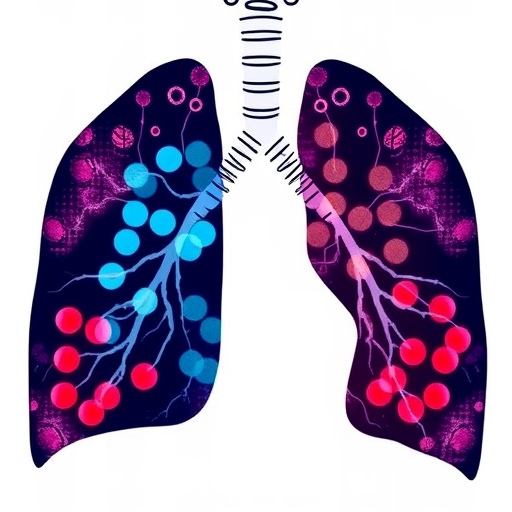In a groundbreaking study published in BioMedical Engineering OnLine, researchers have unveiled the profound prognostic significance of circulating lymphocyte subpopulations in patients battling advanced non-small cell lung cancer (NSCLC). This investigation shines a spotlight on stage III–IV NSCLC individuals undergoing treatment with epidermal growth factor receptor-tyrosine kinase inhibitors (EGFR-TKIs), revealing a nuanced immune landscape that could transform therapeutic approaches and prognostic assessments.
Lung cancer, particularly NSCLC, remains a formidable global health challenge, accounting for a substantial mortality burden. Advanced stages of NSCLC often demand targeted therapeutic strategies, such as EGFR-TKIs, which have revolutionized treatment paradigms by selectively inhibiting aberrant signaling pathways. However, predicting treatment outcomes with precision continues to evade clinicians. This study addresses this gap by delving into the prognostic potential of circulating lymphocyte subsets, an immunological dimension increasingly recognized for its role in cancer progression and response to therapy.
The investigation retrospectively analyzed 72 patients diagnosed with stage III–IV NSCLC, all receiving EGFR-TKI therapy. Patients were stratified based on their clinical responses into three distinct categories: complete or partial remission (remission group), stable disease, and progression. Such stratification allowed for a comparative analysis of immune cell populations circulating in the blood, notably focusing on T lymphocyte subsets and B cells, which are pivotal constituents of the adaptive immune system.
Among the lymphocyte subsets studied, the count of CD4+CD45RA+CD62L+ T cells emerged as a critical determinant. This subset exhibited a striking gradient, with the highest levels observed in patients achieving remission, intermediate levels in those with stable disease, and the lowest in patients experiencing disease progression. The implication is clear: these naïve or central memory T cells potentially confer enhanced immunosurveillance or facilitate more robust anti-tumor immune responses, correlating with favorable therapeutic outcomes.
Contrarily, the study found that CD19+ B cells were significantly elevated in the progression group. While B cells are traditionally known for antibody production, emerging evidence suggests their regulatory complexity in cancer, sometimes promoting tumor growth or immune evasion. This dichotomy underscores the intricate interplay between immune subpopulations and tumor dynamics, highlighting the necessity to parse their contextual roles in different cancer states.
Employing rigorous statistical methodologies, including COX regression modeling, the research identified CD4+CD45RA+CD62L+ T cell count as an independent prognostic factor for progression-free survival (PFS). This finding emancipates the cell subset count from confounding clinical variables, underscoring its potential utility as a biomarker. Such independence supports integrating lymphocyte profiling into routine clinical practice for a more tailored prognostic framework.
Receiver Operating Characteristic (ROC) curve analysis further refined the prognostic precision by establishing an optimal threshold for CD4+CD45RA+CD62L+ T cell counts. The area under the curve (AUC) of 0.84 indicates strong discriminative capacity in predicting patient outcomes. A cut-off value of 126.47 was determined, with a Youden index of 0.570, signifying a balance between sensitivity and specificity. Patients with counts surpassing this threshold demonstrated pronounced improvements in PFS.
Survival analyses using Kaplan-Meier curves reinforced these observations; patients with elevated CD4+CD45RA+CD62L+ T cell levels enjoyed considerably prolonged PFS compared to those below the threshold. This survival advantage accentuates the role these circulating immune cells play in mediating or reflecting therapeutic efficacy, offering a tangible metric for clinicians to monitor treatment trajectories and potentially adapt strategies in real time.
Beyond the immediate clinical implications, these insights challenge the conventional oncology paradigm that predominantly emphasizes tumor-centric factors. Instead, they advocate for a holistic view encompassing the host’s immune competence and its continuous crosstalk with neoplastic cells. Such immunological biomarkers can bridge the gap between molecular-targeted therapy and personalized medicine, ensuring that patients derive maximum benefit from available treatments.
However, the authors prudently caution that circulating lymphocyte subset counts should not be interpreted in isolation. Prognosis in advanced NSCLC is multifactorial, influenced by variables such as staging nuances, specific EGFR-TKI generations, and individual patient comorbidities. A composite assessment model integrating immunological, molecular, and clinical parameters is imperative to fully harness these findings in everyday oncology practice.
This study’s retrospective design invites calls for prospective validation in diverse patient cohorts and exploration of longitudinal immune monitoring. Moreover, mechanistic studies elucidating how these lymphocyte subsets influence tumor-immune dynamics could unveil novel therapeutic targets or combinatory approaches that enhance EGFR-TKI efficacy.
In conclusion, the identification of circulating CD4+CD45RA+CD62L+ T cells as a potent prognostic indicator heralds a potential paradigm shift in managing advanced NSCLC. Through refined immune profiling, oncologists may soon predict patient outcomes with greater accuracy, personalize therapy, and ultimately improve survival rates. This research illuminates the promise of melding immunology with targeted cancer therapeutics, charting a promising path forward in the relentless battle against lung cancer.
Subject of Research:
Article Title: The predictive value of circulating lymphocyte subpopulation characteristics for the prognosis of patients with stage III–IV non-small cell lung cancer treated with EGFR-TKI
Article References: Han, B., Han, Y., Zhang, Q. et al. The predictive value of circulating lymphocyte subpopulation characteristics for the prognosis of patients with stage III–IV non-small cell lung cancer treated with EGFR-TKI. BioMed Eng OnLine 24, 130 (2025). https://doi.org/10.1186/s12938-025-01464-8
Image Credits: AI Generated
DOI: 04 November 2025
Tags: advanced non-small cell lung cancercancer immunology researchcancer progression and therapy responsecirculating T lymphocyte subsetsEGFR-TKI treatment outcomesimmune cell populations in bloodimmune landscape in lung cancerLymphocyte subpopulationsprognostic significance of lymphocytesremission and progression in lung cancerstage III-IV NSCLCtargeted therapeutic strategies for lung cancer





